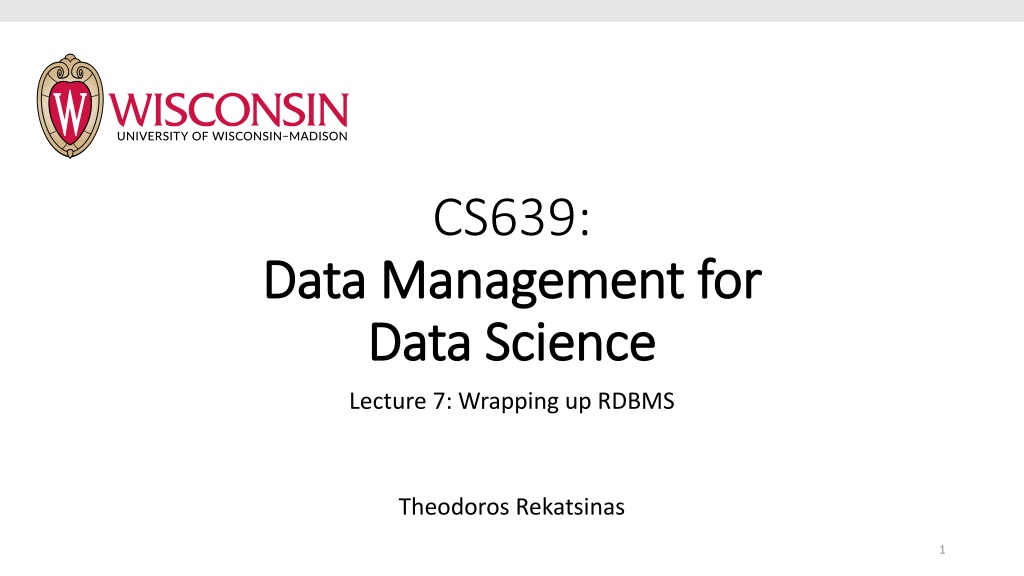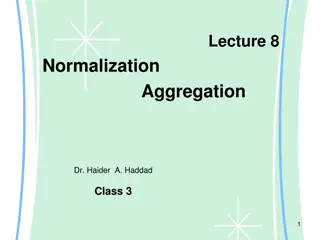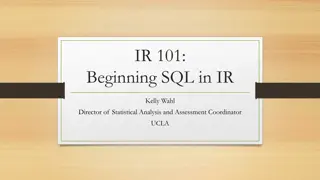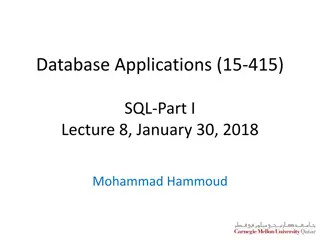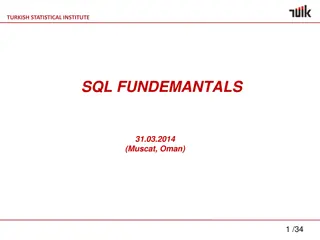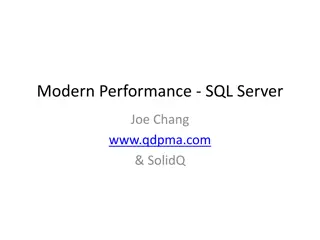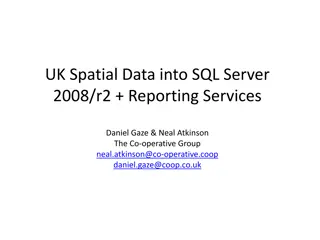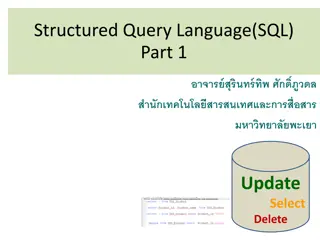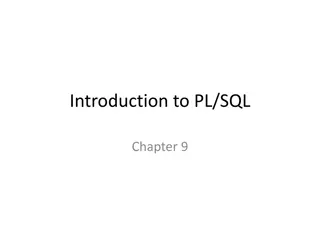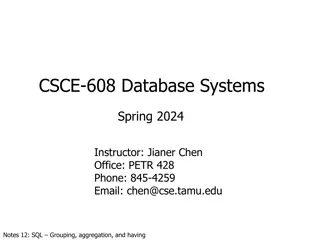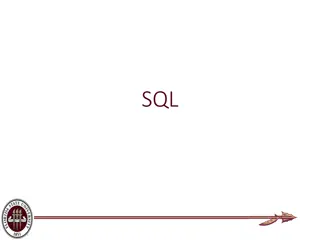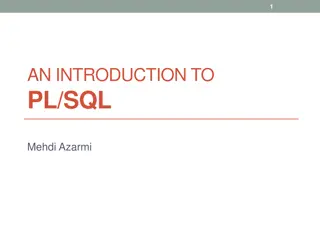SQL Aggregation and Group By: Understanding Concepts and Examples
Exploring SQL aggregation operations such as AVG, COUNT, and more, along with the GROUP BY clause for grouping data based on specific attributes. Examples illustrate how to use these features effectively in SQL queries to retrieve meaningful insights from databases.
Download Presentation

Please find below an Image/Link to download the presentation.
The content on the website is provided AS IS for your information and personal use only. It may not be sold, licensed, or shared on other websites without obtaining consent from the author. Download presentation by click this link. If you encounter any issues during the download, it is possible that the publisher has removed the file from their server.
E N D
Presentation Transcript
CS639: Data Management for Data Management for Data Science Data Science Lecture 7: Wrapping up RDBMS Theodoros Rekatsinas 1
Announcements Final date: To be set. Issue with admins. Questions on PA2? Submission Template Please follow instructions Research projects posted Please sign up to multiple projects that you find interesting Sign up in Slack 2
Todays Lecture 1. Finish SQL 2. Overview of an RDBMS 3. Transactions and ACID 3
Aggregation SELECT AVG(price) FROM Product WHERE maker = Toyota SELECT COUNT(*) FROM Product WHERE year > 1995 SQL supports several aggregation operations: SUM, COUNT, MIN, MAX, AVG Except COUNT, all aggregations apply to a single attribute 5
Aggregation: COUNT COUNT applies to duplicates, unless otherwise stated Note: Same as COUNT(*). Why? SELECT COUNT(category) FROM Product WHERE year > 1995 We probably want: SELECT COUNT(DISTINCT category) FROM Product WHERE year > 1995 6
More Examples Purchase(product, date, price, quantity) SELECT SUM(price * quantity) FROM Purchase What do these mean? SELECT SUM(price * quantity) FROM Purchase WHERE product = bagel 7
Simple Aggregations Purchase Product bagel banana banana Date 10/21 10/3 10/10 Price 1 0.5 1 Quantity 20 10 10 bagel 10/25 1.50 20 SELECT SUM(price * quantity) FROM Purchase WHERE product = bagel 50 (= 1*20 + 1.50*20) 8
Grouping and Aggregation Purchase(product, date, price, quantity) SELECT product, SUM(price * quantity) AS TotalSales FROM Purchase WHERE date > 10/1/2005 GROUP BY product Find total sales after 10/1/2005 per product. Let s see what this means 9
Grouping and Aggregation Semantics of the query: 1. Compute the FROM and WHERE clauses 2. Group by the attributes in the GROUP BY 3. Compute the SELECT clause: grouped attributes and aggregates 10
1. Compute the FROM and WHERE clauses SELECT product, SUM(price*quantity) AS TotalSales FROM Purchase WHERE date > 10/1/2005 GROUP BY product Product Bagel Bagel Banana Banana Date 10/21 10/25 10/3 10/10 Price 1 1.50 0.5 1 Quantity 20 20 10 10 FROM 11
2. Group by the attributes in the GROUP BY SELECT product, SUM(price*quantity) AS TotalSales FROM Purchase WHERE date > 10/1/2005 GROUP BY product Product Bagel Bagel Banana Banana Date 10/21 10/25 10/3 10/10 Price 1 1.50 0.5 1 Quantity 20 20 10 10 Product Date 10/21 10/25 10/3 10/10 Price 1 1.50 0.5 1 Quantity 20 20 10 10 GROUP BY Bagel Banana 12
3. Compute the SELECT clause: grouped attributes and aggregates SELECT product, SUM(price*quantity) AS TotalSales FROM Purchase WHERE date > 10/1/2005 GROUP BY product Product Date 10/21 10/25 10/3 10/10 Price 1 1.50 0.5 1 Quantity 20 20 10 10 Product TotalSales SELECT Bagel Bagel 50 Banana 15 Banana 13
HAVING Clause Same query as before, except that we consider only products that have more than 100 buyers SELECT product, SUM(price*quantity) FROM Purchase WHERE date > 10/1/2005 GROUP BY product HAVING SUM(quantity) > 100 HAVING clauses contains conditions on aggregates aggregates Whereas WHERE clauses condition on individual tuples individual tuples 14
General form of Grouping and Aggregation SELECT S FROM R1, ,Rn WHERE C1 GROUP BY a1, ,ak HAVING C2 Why? S = Can ONLY contain attributes a1, ,ak and/or aggregates over other attributes C1 = is any condition on the attributes in R1, ,Rn C2 = is any condition on the aggregate expressions 15
General form of Grouping and Aggregation SELECT S FROM R1, ,Rn WHERE C1 GROUP BY a1, ,ak HAVING C2 Evaluation steps: 1. Evaluate FROM-WHERE: apply condition C1 on the attributes in R1, ,Rn GROUP BY the attributes a1, ,ak Apply condition C2 to each group (may have aggregates) Compute aggregates in S and return the result 2. 3. 4. 16
Group-by v.s. Nested Query Author(login, name) Wrote(login, url) Find authors who wrote 10 documents: Attempt 1: with nested queries SELECT DISTINCT Author.name FROM Author WHERE COUNT( SELECT Wrote.url FROM Wrote WHERE Author.login = Wrote.login) > 10 This is SQL by a novice 17
Group-by v.s. Nested Query Find all authors who wrote at least 10 documents: Attempt 2: SQL style (with GROUP BY) SELECT Author.name FROM Author, Wrote WHERE Author.login = Wrote.login GROUP BY Author.name HAVING COUNT(Wrote.url) > 10 This is SQL by an expert No need for DISTINCT: automatically from GROUP BY 18
Group-by vs. Nested Query Which way is more efficient? Attempt #1- With nested: How many times do we do a SFW query over all of the Wrote relations? Attempt #2- With group-by: How about when written this way? With GROUP BY can be much much more efficient!
RDBMS Architecture How does a SQL engine work ? Relational Algebra (RA) Plan SQL Query Optimized RA Plan Execution Declarative query (from user) Translate to relational algebra expression Find logically equivalent- but more efficient- RA expression Execute each operator of the optimized plan!
SQL Query Logical vs. Physical Optimization Relational Algebra (RA) Plan Logical optimization (we will only see this one): Find equivalent plans that are more efficient Intuition: Minimize # of tuples at each step by changing the order of RA operators Optimized RA Plan Physical optimization: Find algorithm with lowest IO cost to execute our plan Intuition: Calculate based on physical parameters (buffer size, etc.) and estimates of data size (histograms) Execution
Recall: Logical Equivalence of RA Plans Given relations R(A,B) and S(B,C): Here, projection & selection commute: ??=5( ?(?)) = ?(??=5(?)) What about here? ??=5( ?(?)) ?= ?(??=5(?))
Translating to RA R(A,B) S(B,C) T(C,D) ?,? SELECT R.A,S.D FROM R,S,T WHERE R.B = S.B AND S.C = T.C AND R.A < 10; T(C,D) R(A,B) S(B,C) ?,?(??<10? ? ? )
Logical Optimization Heuristically, we want selections and projections to occur as early as possible in the plan Terminology: push down selections and pushing down projections. Intuition: We will have fewer tuples in a plan. Could fail if the selection condition is very expensive (say runs some image processing algorithm). Projection could be a waste of effort, but more rarely.
Optimizing RA Plan Push down selection on A so it occurs earlier R(A,B) S(B,C) T(C,D) ?,? SELECT R.A,S.D FROM R,S,T WHERE R.B = S.B AND S.C = T.C AND R.A < 10; T(C,D) R(A,B) S(B,C) ?,?(??<10? ? ? )
Optimizing RA Plan Push down selection on A so it occurs earlier R(A,B) S(B,C) T(C,D) SELECT R.A,S.D FROM R,S,T WHERE R.B = S.B AND S.C = T.C AND R.A < 10; ?,? T(C,D) S(B,C) ?,?? ??<10(?) ? R(A,B)
Optimizing RA Plan Push down projection so it occurs earlier R(A,B) S(B,C) T(C,D) SELECT R.A,S.D FROM R,S,T WHERE R.B = S.B AND S.C = T.C AND R.A < 10; ?,? T(C,D) S(B,C) ?,?? ??<10(?) ? R(A,B)
Optimizing RA Plan We eliminate B earlier! R(A,B) S(B,C) T(C,D) ?,? In general, when is an attribute not needed ? SELECT R.A,S.D FROM R,S,T WHERE R.B = S.B AND S.C = T.C AND R.A < 10; T(C,D) ?,? ?,? ? ?,???<10(?) ? S(B,C) R(A,B)
Transactions: Basic Definition In the real world, a TXN either happened completely or not at all A transaction ( TXN ) transaction ( TXN ) is a sequence of one or more operations operations (reads or writes) which reflects a single real world transition world transition. a single real- - START TRANSACTION UPDATE Product SET Price = Price 1.99 WHERE pname = Gizmo COMMIT
Transactions: Basic Definition In the real world, a TXN either happened completely or not at all A transaction ( TXN ) transaction ( TXN ) is a sequence of one or more operations operations (reads or writes) which reflects a single real a single real- -world transition world transition. Examples: Transfer money between accounts Purchase a group of products Register for a class (either waitlist or allocated)
Transactions in SQL In ad-hoc SQL: Default: each statement = one transaction In a program, multiple statements can be grouped together as a transaction: START TRANSACTION UPDATE Bank SET amount = amount 100 WHERE name = Bob UPDATE Bank SET amount = amount + 100 WHERE name = Joe COMMIT 33
Transaction Properties: ACID Atomic State shows either all the effects of txn, or none of them Consistent Txn moves from a state where integrity holds, to another where integrity holds Isolated Effect of txns is the same as txns running one after another (ie looks like batch mode) Durable Once a txn has committed, its effects remain in the database ACID continues to be a source of great debate! 34
A ACID: A Atomicity TXN s activities are atomic: all or nothing Intuitively: in the real world, a transaction is something that would either occur completely or not at all Two possible outcomes for a TXN It commits: all the changes are made It aborts: no changes are made 35
Transactions A key concept is the transaction (TXN): anatomic sequence of db actions (reads/writes) Atomicity Atomicity: An action either completes entirely or not at all Acct a10 a20 Balance 20,000 15,000 Acct a10 a20 Balance 17,000 18,000 Transfer $3k from a10 to a20: 1. Debit $3k from a10 2. Credit $3k to a20 Crash before 1, After 1 but before 2, After 2. Written naively, in which states is atomicity preserved? DB Always preserves atomicity! 36
AC CID: C Consistency The tables must always satisfy user-specified integrity constraints Examples: Account number is unique Stock amount can t be negative Sum of debits and of credits is 0 How consistency is achieved: Programmer makes sure a txn takes a consistent state to a consistent state System makes sure that the txn is atomic 37
ACI ID: I Isolation A transaction executes concurrently with other transactions Isolation: the effect is as if each transaction executes in isolation of the others. E.g. Should not be able to observe changes from other transactions during the run 38
Challenge: Scheduling Concurrent Transactions The DBMS ensures that the execution of {T1, ,Tn} is equivalent to some serialexecution A set of TXNs is isolated isolated if their effect is as if all were executed serially One way to accomplish this: Locking Before reading or writing, transaction requires a lock from DBMS, holds until the end What if Ti and Tj need X and Y, and Ti asks for X before Tj, and Tj asks for Y before Ti? -> Deadlock! One is aborted Key Idea:If Ti wants to write to an item x and Tj wants to read x, then Ti, Tjconflict. Solution via locking: only one winner gets the lock loser is blocked (waits) until winner finishes All concurrency issues handled by the DBMS 39
ACID D: D Durability The effect of a TXN must continue to exist ( persist ) after the TXN And after the whole program has terminated And even if there are power failures, crashes, etc. And etc Means: Write data to disk 40
Ensuring Atomicity & Durability DBMS ensures atomicity even if a TXN crashes! Write Write- -ahead Logging ahead Logging (WAL): (WAL): Before any action is finalized, a corresponding log entry is forced to disk One way to accomplish this: Write-ahead logging (WAL) Key Idea:Keep a log of all the writes done. After a crash, the partially executed TXNs are undone using the log We assume that the log is on stable storage All atomicity issues also handled by the DBMS 41
Challenges for ACID properties In spite of failures: Power failures, but not media failures Users may abort the program: need to rollback the changes Need to log what happened Many users executing concurrently Can be solved via locking (we ll see this next lecture!) And all this with Performance!!
A Note: ACID is contentious! Many debates over ACID, both historically and currently Many newer NoSQL DBMSs relax ACID In turn, now NewSQL reintroduces ACID compliance to NoSQL-style DBMSs ACID is an extremely important & successful paradigm, but still debated!
Summary of DBMS DBMS are used to maintain, query, and manage large datasets. Provide concurrency, recovery from crashes, quick application development, integrity, and security Key abstractions give data independence DBMS R&D is one of the broadest fields in CS. Fact! 44
